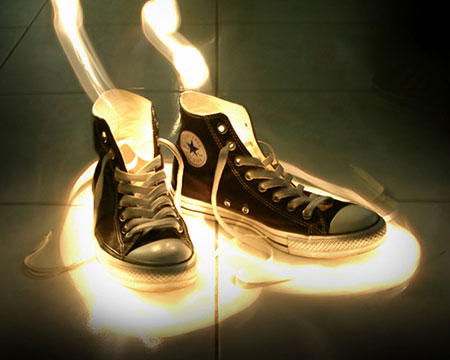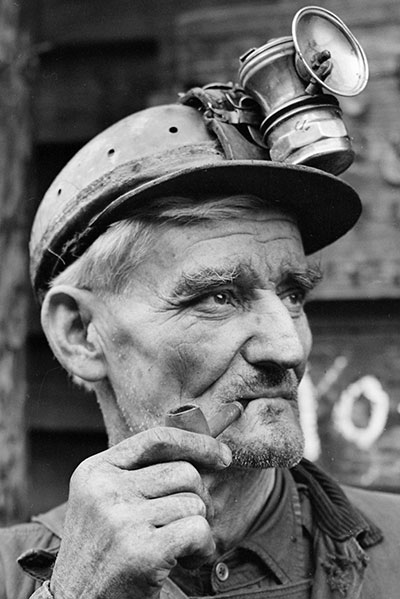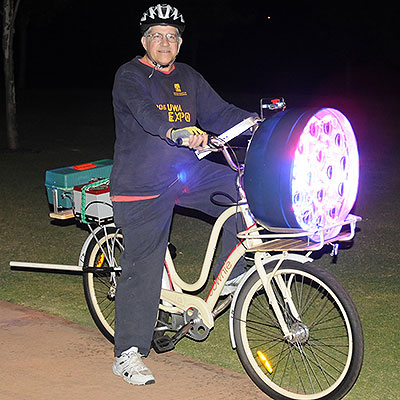Last weekend daylight saving ended in much of Australia, marking our sudden plunge into darkness in the early evenings. As a guide for commuting cyclists who are now faced with panic-buying new bike lights, I offer this list of seven nine mistakes in bike lighting. See how many you can collect.
0. Not having any lights
You don't score anything for this one. Much as it would be great to not need lights for our own protection, we do. And even if your ride home is all smooth bitumen and perfect street lights door-to-door, you still need lights to see with.
 Close-up of an unlit cyclist at night
Close-up of an unlit cyclist at night
And bugger it, it's simply the damn law: to ride a bike at night, the road rules in Victoria (pretty much the same across Australia) require lights that are visible 200m from the front and the rear of the bike (white at the front, red at the back).
1. Not mounting lights on the bike
When worn on your body a light gains the benefit of very 'human' dimensions, especially when the light outlines the most mobile outer extremities of the body (feet/ankles, hands/wrists, head). Probably the best example of this that I've seen was ten or more years ago on a commuter who passed me one night—he had small red LEDs mounted on his mitts in such a way that when he put his hands out on his MTB handlebar extensions the red lights shone straight backwards, perfectly defining the full width of his vehicle. I presume he went to some trouble to get the angle of the lights exactly right.
 Lighting the mobile extremities enhances your 'human' dimensions
Lighting the mobile extremities enhances your 'human' dimensions
But even with the greatest of care in adjustment and use, body-mounted lights should not be primary lights. The only way to guarantee that you have the basics covered—a beam of light directly to the front and a beam of light directly to the rear—is to have primary lights mounted on the bike itself. Those primaries must be mounted securely and adjusted so that they project a steady and unimpeded beam to the roadway ahead/behind.
Mounting to luggage (such as a rack bag or handlebar bag) is rarely secure or steady and mounting a light to a backpack or courier bag is pot luck at best, particularly when the rider is bent down over the handlebars. There's nothing wrong with mounting secondary/supplementary lights in these kind of spots.
One other thing that you should do with bike mounted lights: when you arrive at your destination and it's dark, prop up your bike and walk back a dozen paces. Are your rear lights as bright and visible as you expect? Sometimes you can get a nasty surprise.
2. Mounting lights on the kerb side
This is one of those minor, slightly annoying things that completely rubs my fur the wrong way. Given the choice of mounting a headlight to the right or the left side of the handlebars, a surprisingly large number of riders choose to put it on the kerb side, that is, to the left (in Australia, lefthand rule of the road).
Why does this matter? In the absence of any (or much) other information, an approaching driver (or rider) will probably assume that a single headlight represents the centre of your vehicle (as it does with a motorcycle). This is an assumption you want to exploit by maximising passing distances (especially passing at close quarters, as you may do on a cycle path). Sure it's only a difference of 5cm, maybe 10cm at most, so in practice it probably doesn't really matter but why make yourself look that much narrower?
The same thing applies to mounting a rear light on the seat stays: put it on the outside not the kerb side seat stay or (better yet) put one on each seat stay.
For what it's worth, at the front I go with a centrally mounted primary light and a flasher that's offset both horizontally (to the outside) and vertically (lower) than the primary. My rear lighting is similarly asymmetrical. I think asymmetry is a great way of creating a desirable level of intrigue and uncertainty in my lighting.
3. Having a flashing light only
I've said it before: getting good distance and speed perception is much harder for a flashing light than it is for a static beam. Have a flashing visibility light to catch each driver's attention, and a static beam to give them something to focus that attention on.
 The whole point of a flashing light is to attract attention Photo: SplitShire
The whole point of a flashing light is to attract attention Photo: SplitShire
I quite deliberately said 'driver' in the previous paragraph. The whole point of a flashing light is to attract attention, often in an already brightly lit environment, where drivers' attention may be divided. Who really thinks that's necessary on an off-road path? To other path users flashing your headlights is annoying to the point of being downright dangerous. The mere presence of a bright bike light is enough to alert other path users to your approach, especially when such paths are usually badly lit. If your commute takes you by off-road paths, show yourself to be a 'grown-up' cyclist and switch your flashers to static until you're back on roads shared with motor vehicles.
4. Using a helmet light
A major problem with helmet lights is that the beam of light goes right where you look, and often that's right into the face of oncoming road/path users. It's just human nature that we tend to scan the faces of other people as they approach, whether we're looking for a face we recognise or (importantly in traffic) trying to gauge the attitude/disposition/intentions of the other person. The worst case scenario for this is on a dark off-road path, where a sudden eye-level flash of helmet-mounted glare can totally destroy otherwise effective night vision in an oncoming rider. The possibility of a head-on collision in this situation is real.
 "Yep, it's a helmet light—you got a problem with that?"
"Yep, it's a helmet light—you got a problem with that?"
Regardless of what you think about helmets for cycling, there are quite plausible collision scenarios where having a heavy and rigid object attached to the outside of a helmet could make head injuries worse than they otherwise might have been (the most obvious example is the speculation that Michael Schumacher's brain injury may have been due to a GoPro camera attached to his helmet).
5. Not using a helmet light
A major advantage with helmet lights is that the beam of light goes right where you look, and often that's right where you need light that's not being provided by your headlights or ambient street lighting. Think about avoiding debris and broken edges while turning from a bright road into a darker side street, negotiating bollards and overhanging branches on a path in an unlit park, or any tight cornering in the dark.
There is a role for helmet lights in collision avoidance, where they can be used as a warning device in a similar way that drivers use their 'flashable' headlights or even their horns. Pointing a helmet light so as to 'flash' an inattentive driver through their side window or wing mirror, for example, is a valid safety technique for a cyclist. And a helmet light tends to move in the 'human' dimension mentioned above, with the added advantage of being up high—often above the roof level of surrounding cars, which greatly increases the range of visibility for the cyclist.
6. Running your batteries down
Now come on, buy some bloody rechargeable batteries and change them regularly. Is your life, health, and wellbeing really worth trying to wring every last cent of 'value' out of a non-rechargeable battery?
 Burning your batteries right down: you know it's not really good value. Photo: kev-shine
Burning your batteries right down: you know it's not really good value. Photo: kev-shine
At this point, some commuters and many Audax riders will be shaking their heads and muttering about dynohubs, and I can see their point.
7. Entering the arms race
Even a few years ago, I never would have thought that it would be possible to have too much of a good thing when it comes to bike lighting. I always found it laughable that drivers would complain about bicycle lighting being too bright, when the beam of my reasonably powerful Ay-Up headlight is so easily overwhelmed by the flare of high-beam lights of a car approaching from behind.
But I think I've reached a tipping point. We now have pretty easy access to some very impressive lighting hardware that sits in the sweet spot for strong light output, long battery life, compactness, and price. The thing is, when you take kit that's basically intended to be portable daylight—capable of lighting up a darkened MTB trail and setting fire to small furry creatures at close range—and deploy it on the road and/or urban shared trails, it's like 'roo shooters bringing their spotlights to town. Sure, it lights your way, but it's pretty excessive for the purpose.
 If you think this would look good on the front of your bike, you're in the arms race. Photo: tesladownunder
If you think this would look good on the front of your bike, you're in the arms race. Photo: tesladownunder
It's been sad to see a minority of riders take a "f–k you—I'm all right, Jack" attitude in defence of bringing high-level MTB lighting to urban roads. The argument goes (more-or-less): "More light makes me more safe, so bring on more lumens and bugger whether it dazzles anyone else—driver or cyclist." The lunacy of the argument could not be plainer. Firstly, dazzling brightness does not make the rider with the brightest light more safe if their lights actually impair the vision of other road users and make it harder for them to control their vehicles safely. Secondly, it's 'arms race' thinking, encouraging an escalating battle that cyclists are unlikely to win.
One obvious way that we won't win such an arms race is if law is brought into effect that limits our access to or use of high intensity lighting. You can bet your arse that if it ever came to legislation, the motoring lobby would work hard to have recommended levels of bike lighting that would almost certainly be much less than most of us would consider safe or practical.
In passing, I mention that VicRoads' cycling related road rules survey conducted last year included a number of questions about brightness of bicycle lighting. Now why would they be asking about that, I wonder?
8. Red at the front, white at the back
After I posted this, @plunger007 noted that "putting wrong colour on wrong end would be up there for me". I've mentioned this before but I hadn't seen it for ages, so I'd almost forgotten about it. Then within days of releasing this post, I was startled by a rider with a red headlight (also riding the wrong way into a one-way street, go figure). It still happens then, so this one goes straight back on the list.
I can't imagine why people think this is a good idea. It's a plain dumb thing to do. Just like running flashing lights only, putting the wrong colour lights at the wrong end could easily cause a driver to misjudge your position on the road and the speed that you're moving—those aren't things that I want a driver to get wrong.
9. Lack of redundancy
When I initially posted, I wasn't going to put this down as a mistake either. Having two lights at the front and two at the back can seem a bit like Audax-style belt-and-braces fussiness.
But a relatively short commute ride is plenty of time for a light to fail or fall off, and only have one rear light, chances are you won't notice the failure until you get to your destination.
So yeah, I'm call it a mistake to go out without two full sets of lights.